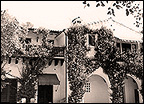December 6, 2004
By facsimile and mail
Ms. Hope Sullivan
Director of Planning and Building
Town of Woodside
P.O. Box 620005
Woodside, California 94062
Fax: (650) 851-2195
RE: Jackling Estate Demolition - Appeal Before Town Council
Dear Ms. Sullivan:
On behalf of the National Trust for Historic Preservation, thank you for the
opportunity to comment on the Town Council's review of the proposed
demolition of the Jackling House for construction of a single-family
residence. Because the Environmental Impact Report does not include a
complete project description, the Planning Commission's rejection of
alternatives must be considered premature and unsubstantiated. The Trust is
convinced that the Jackling House can be feasibly rehabilitated and returned
to its original use as a residence, especially if the likely costs of the
proposed project are taken into account.
The National Trust is a private, nonprofit membership organization dedicated
to protecting the irreplaceable. Recipient of the National Humanities
Medal, the Trust provides leadership, education and advocacy to save
America's diverse historic places and revitalize communities. Its
Washington, DC headquarters staff, six regional offices and 21 historic
sites (including Woodside's Filoli) work with the Trust's 200,000 members and
thousands of local community groups in all 50 states, including over 20,000
members in California alone. The Western Office of the Trust previously
submitted written comments on the Draft EIR for this project on March 12,
2004 and testified before the Planning Commission at its hearing on June 2,
2004.
I. The Jackling House is a historic resource subject to protection under
the California Environmental Quality Act
A key policy under the California Environmental Quality Act (CEQA) is
the lead agency's duty to "take all action necessary to provide the people
of this state with historic environmental qualities and preserve for future generations examples of
major periods of California history."
(PRC ¤21001 (b),(c).) CEQA "requires public agencies to deny approval of a project with significant adverse
effects when feasible alternatives or feasible mitigation measures can
substantially lessen such effects."
(Sierra Club v. Gilroy City Council (1990) 222 Cal.App.3d 30, 41, italics added; also see PRC ¤¤ 21002,
21002.1.)
Designed in 1926 by renowned architect George Washington Smith, the EIR
concludes that the Jackling House is eligible for the California Register of
Historic Places as a notable example of the Spanish Colonial Revival
architecture and also for its association with Daniel C. Jackling, "the most
important figure in the American copper industry of his day."(DEIR, 5.1-4)
Despite ultimately approving demolition, the Planning Commission's findings
recognize that the Jackling House qualifies as an historic resource under
CEQA, and requires preparation of an EIR to evaluate the impacts of and
alternatives to the proposed project. (CEQA Findings, June 16, 2004)
II. The EIR's project description lacks "specific details" necessary to
evaluate the feasibility of alternatives to demolition
"An accurate, stable and finite project description is the sine qua non
of an informative and legally sufficient EIR."
County of Inyo v. City of Los Angeles (1977) 71 Cal.App.3d 185.
Accordingly, the EIR must contain a detailed description of the project
being reviewed, including the physical development that will result if the
project is approved. Guideline ¤ 15124.
The Draft EIR originally defined the project as demolition only
("Jackling Estate Demolition"), although new construction was clearly
intended by the applicant. In response to comments on the Draft EIR, the
Final EIR expanded the project definition to include both demolition and
construction of a single-family residence, but did not describe the new
house in any way. Although the EIR estimates the costs of alternatives
($4.9 to $9.0 million), it does not calculate total project costs, including
demolition of the Jackling House and construction of an entirely new
residence. Depending on the "specific characteristics" of the project, up
to three alternatives in the EIR "might meet the objective of eventual
construction of a single-family residence." (FEIR, 13.0-7) However, without
a detailed description of the proposed project, there is no basis for
weighing alternatives and evaluating their feasibility.
III. The Planning Commission's findings rejecting project alternatives as
infeasible are not supported by substantial evidence
The findings of the lead agency must be supported by substantial
evidence in the record: "[T]he requirement [of findings] ensures there is
evidence of the public agency's actual consideration of alternatives and
mitigation measures, and reveals to citizens the analytical process by which
the public agency arrived at its decision." Mountain Lion Foundation v.
Fish & Game Comm'n (1997) 16 Cal.4th 105, 134.
Despite having no information about project costs, the Planning
Commission summarily concluded that rehabilitation alternatives were
"economically unjustifiable." (CEQA Findings, June 16, 2004) Although
economic factors are commonly used to determine feasibility under CEQA, the
rationale for finding an alternative infeasible must be explained in the
EIR. Laurel Heights Improvement Association v. Regents of the University of
California (1988) 47 Cal.3d 376. Because the EIR fails to include costs or
any "specific characteristics" of the proposed project, it is impossible to
trace the "analytical process" followed by the Planning Commission in
rejecting alternatives. As such, the Planning Commission's findings are not
supported by substantial evidence and should be set aside.
Thank you for the opportunity to comment on proposed demolition of the
Jackling House. Please feel free to contact me at (415) 956-0610 or mike_buhler@nthp.org should you have any questions.
Sincerely,
Michael Buhler
Regional Attorney
|
|
ACTION TO SAVE THIS HOUSE AND HOW YOU CAN GET INVOLVED
HELP WITH A DONATION TOWARDS OUR LEGAL COSTS
ABOUT THE ARCHITECT AND THIS HOUSE
PRESS ON THE JACKLING HOUSE
PHOTO GALLERY: THE HOUSE THEN & NOW
MORE ON THE JACKLING HOUSE
ACROSS THE COUNTRY PEOPLE THINK IT MATTERS TO SAVE THIS HOUSE
FROM THE PUBLIC RECORD: LETTERS OF SUPPORT
BACK TO HOMEPAGE
Help us thanks to the National
Trust

|
|

